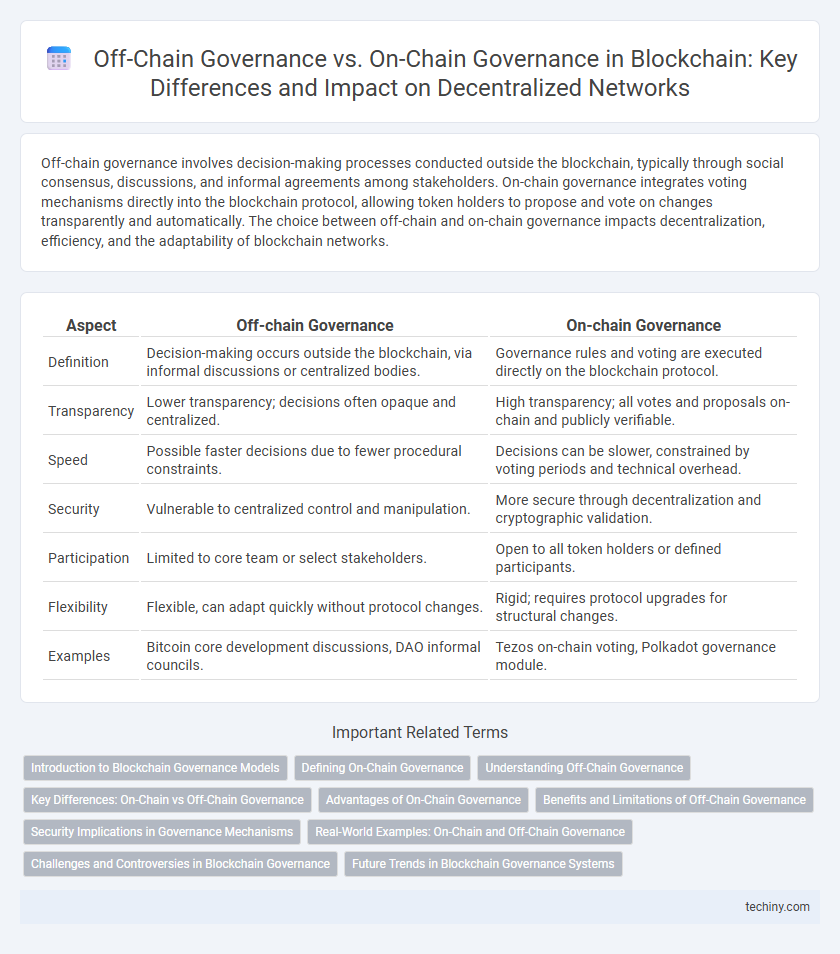Off-chain governance involves decision-making processes conducted outside the blockchain, typically through social consensus, discussions, and informal agreements among stakeholders. On-chain governance integrates voting mechanisms directly into the blockchain protocol, allowing token holders to propose and vote on changes transparently and automatically. The choice between off-chain and on-chain governance impacts decentralization, efficiency, and the adaptability of blockchain networks.
Table of Comparison
| Aspect | Off-chain Governance | On-chain Governance |
|---|---|---|
| Definition | Decision-making occurs outside the blockchain, via informal discussions or centralized bodies. | Governance rules and voting are executed directly on the blockchain protocol. |
| Transparency | Lower transparency; decisions often opaque and centralized. | High transparency; all votes and proposals on-chain and publicly verifiable. |
| Speed | Possible faster decisions due to fewer procedural constraints. | Decisions can be slower, constrained by voting periods and technical overhead. |
| Security | Vulnerable to centralized control and manipulation. | More secure through decentralization and cryptographic validation. |
| Participation | Limited to core team or select stakeholders. | Open to all token holders or defined participants. |
| Flexibility | Flexible, can adapt quickly without protocol changes. | Rigid; requires protocol upgrades for structural changes. |
| Examples | Bitcoin core development discussions, DAO informal councils. | Tezos on-chain voting, Polkadot governance module. |
Introduction to Blockchain Governance Models
On-chain governance integrates decision-making processes directly into the blockchain protocol, enabling stakeholders to vote on proposals transparently and automatically enforce changes. Off-chain governance relies on external discussions and informal consensus among network participants, often facilitated through forums, social media, or developer meetings, before any changes are enacted. These governance models address scalability, security, and adaptability challenges inherent in managing decentralized blockchain ecosystems.
Defining On-Chain Governance
On-chain governance refers to a blockchain-based decision-making process where protocol changes are proposed, voted on, and executed directly through smart contracts on the blockchain. This mechanism ensures transparency, automatic enforcement, and reduced reliance on external intermediaries, enhancing decentralization. Key platforms like Tezos and Polkadot utilize on-chain governance to enable stakeholders to participate in protocol upgrades and policy adjustments efficiently.
Understanding Off-Chain Governance
Off-chain governance involves decision-making processes that occur outside the blockchain, typically through forums, social media, or private meetings, allowing flexibility and scalability without directly altering on-chain protocols. This model relies heavily on community consensus, informal agreements, and trusted leadership to guide project development and resolve disputes. Off-chain governance is crucial for handling complex decisions that require nuanced discussion, which on-chain voting mechanisms may not effectively address due to limitations in transparency and voter participation.
Key Differences: On-Chain vs Off-Chain Governance
On-chain governance involves decision-making processes executed directly on the blockchain via smart contracts, enabling transparent, automated voting and protocol upgrades recorded on the ledger. Off-chain governance relies on community discussions, proposals, and consensus reached through external platforms like forums or social media, with implementation often dependent on core developers or stakeholders. Key differences include the level of transparency, speed of decision execution, and degree of decentralization, where on-chain governance offers more formalized and verifiable outcomes compared to the flexible but less formal off-chain methods.
Advantages of On-Chain Governance
On-chain governance provides enhanced transparency and accountability by recording all decisions and votes directly on the blockchain, enabling real-time monitoring and verifiable outcomes. It facilitates automated enforcement of protocol upgrades and rule changes through smart contracts, reducing the risk of human error or manipulation. This system empowers decentralized participation, allowing token holders to influence project direction while ensuring faster, more efficient decision-making processes compared to traditional off-chain governance models.
Benefits and Limitations of Off-Chain Governance
Off-chain governance offers increased flexibility and faster decision-making by enabling stakeholders to discuss and negotiate outside the blockchain, reducing on-chain transaction costs and congestion. This approach fosters more inclusive participation through off-chain forums, social media, and community meetings, promoting collaboration among diverse groups. However, off-chain governance lacks the transparency and automatic enforcement of on-chain mechanisms, potentially leading to centralization risks and reduced accountability.
Security Implications in Governance Mechanisms
On-chain governance enables transparent, automated decision-making through smart contracts, reducing manipulation risks but increasing vulnerability to code exploits. Off-chain governance relies on human consensus and social coordination, which can mitigate technical attack vectors but introduces risks of centralization and collusion. Security in governance mechanisms must balance the resilience of decentralized protocols with the flexibility and oversight of community-driven processes.
Real-World Examples: On-Chain and Off-Chain Governance
On-chain governance, exemplified by projects like Tezos and Decred, enables token holders to propose, debate, and vote on protocol upgrades directly via smart contracts, ensuring transparent and automated decision-making. Off-chain governance, as seen in Bitcoin and Ethereum, relies on informal social consensus, developer discussions, and community signaling outside the blockchain, allowing flexibility but slower coordination. These models highlight trade-offs in decentralization, speed, and inclusivity, shaping how blockchain ecosystems evolve and adapt in practice.
Challenges and Controversies in Blockchain Governance
Off-chain governance faces challenges in transparency and inclusivity, often relying on informal decision-making by influential stakeholders, which can lead to centralization and power imbalances. On-chain governance introduces controversies surrounding voting mechanisms and token-based influence, risking plutocracy and voter manipulation due to unequal token distribution. Both models struggle with balancing efficiency, security, and fair representation amid evolving blockchain ecosystems.
Future Trends in Blockchain Governance Systems
Future trends in blockchain governance systems indicate a growing hybrid approach combining off-chain and on-chain mechanisms to balance decentralization and efficiency. Enhanced interoperability protocols and improved voting systems on-chain will enable more transparent, secure decision-making, while off-chain governance continues facilitating flexible community engagement and dispute resolution. The integration of AI-driven analytics and real-time data feeds promises to optimize governance strategies and predict stakeholder consensus more accurately.
Off-chain governance vs On-chain governance Infographic

 techiny.com
techiny.com